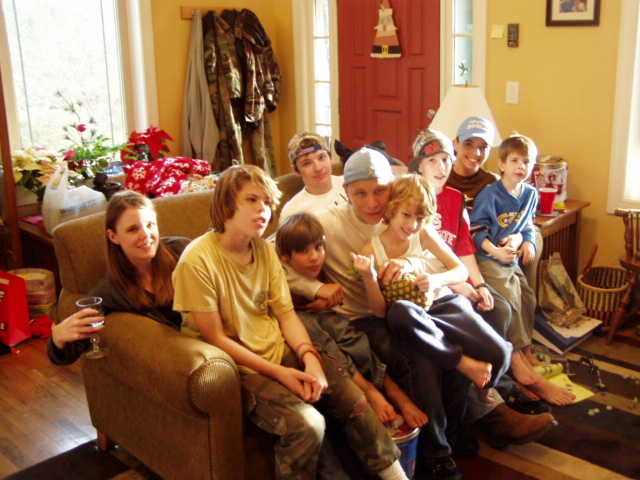Remembering Robert F. (Bobby) Maynard
February 23, 1966 - January 10, 2016
 Good
afternoon. I’m Suzy Barile, Bobby’s
oldest sister – in fact, the oldest of this clan of Maynard kids! It was just
three years ago in January that we asked you to come mourn with us the untimely
death of our youngest sibling, Pattie, and now we are gathered to do the same
for the next youngest, Bobby.
Good
afternoon. I’m Suzy Barile, Bobby’s
oldest sister – in fact, the oldest of this clan of Maynard kids! It was just
three years ago in January that we asked you to come mourn with us the untimely
death of our youngest sibling, Pattie, and now we are gathered to do the same
for the next youngest, Bobby.
Being the
oldest means knowing just about everything about the other kids in the family,
making me best able to share stories from our childhood. You’re probably aware
that Bobby has an older twin, Tommy. Friends of theirs are lucky they weren’t
named ALOYSIUS and DELICIOUS or BERNIE and GERNIE, for at bedtime on the nights
leading up to their February 23, 1966, birth, we’d dream up TWIN names! And
Bobby and Tommy should consider themselves lucky that they were NOT triplets,
as we smartee-pants older siblings would
often reply to strangers who’d see them in their double stroller and inquire, “Are
they twins,” with “No, they’re triplets. The other one is at home.”
But being
twins – and older brothers to Pattie – meant there was double, and sometimes
triple, mischief. They taught her how to pull up the bottom of the wooden-floor
playpen and escape! They decided to play soccer, and so did she! And they
shared a bedroom – with her!
Bobby was
the twin who didn’t mind taking a risk – as a new driver’s license holder, he
did much of the driving on a summer cross-country trip with our Mom. And when
Tommy became interested in volunteering at the Cary Rescue Squad, Bobby headed
to YRAC Volunteer Fire Department. Mom even had a scanner at home so she could
listen to what they were doing!
Bobby was
also the twin who was the most passionate about all he did in life – sorry,
Tommy, not that you don’t love your job. But as a volunteer firefighter – and
later a volunteer EMT – Bobby was ready to run a call the moment the sirens
sounded. As a big brother, he was ready to defend his little sister against any
slights. As an uncle, he was there with a pocketful of quarters to hand out to
any niece or nephew who proclaimed him “favorite uncle.”
And then a
few years ago, he decided to become a long-distance truck-driver so he could
travel the roads of this country and see first-hand the history of the United
States. With his cat, a small fridge filled with Mello Yellow, a microwave in
which to heat his ever-present cup of coffee, and his next assignment, he was
like a kid enjoying a never-ending summer vacation. The Facebook posts of his
adventures were a joy to read!
Because
Bobby and Tommy were just 7 when I went off to college, I wasn’t always around
for the “firsts” – the accomplishments we celebrate as children grow, such as
riding a bicycle for the first time, scoring that first-ever soccer goal, or
going to a school dance and finding the girl of your dreams. Unlike with
Donnie, the oldest Maynard boy, I didn’t have to teach Bobby how to swing a bat
or catch a baseball, because by the time he needed those skills, our
Navy-captain Dad was on shore duty and home to do it.
But as Bobby
got his first job and a checking account, I tried to teach him how to
understand that just because the ATM machine said you had $200, didn’t mean it
could be spent – it might be next week’s car payment money! And because I gave
birth to the first niece, he practiced uncle skills on my daughter Jen. Mom let
the twins and Pattie play hookey from school the day she was born so they could
be home when the phone call came from the hospital in Frederick, Maryland. In
fact, my favorite photograph is of him holding month-old Jen in one arm while stirring
the gravy for Christmas dinner with the other. The beaming smile on his face
when he was with his 10 Maynard nieces and nephews, and those belonging to the
Sauls and Proveaux families, let you know how much love he had to share.
It
was the bountiful love and compassion he had that was his biggest weakness, for
Bobby would give the shirt off his back if someone else needed it. He’d go out
of his way to help anyone – even strangers. As such, Bobby’s pockets were often
empty, but his heart was bursting with the good that he did. He had the trust
of a child, the daring of a teen who never thinks anything will happen to him,
and the unconditional love that allowed him to continue loving, even when he
had been wronged. I’m not saying he wouldn’t get angry and try to figure out
why a wrong had happened, but while I can claim “my mother taught me manners,”
and be polite even when I don’t want to be, Bobby was genuine.
This is the
brother I will remember, and the person I hope you had the privilege to know,
as well.










